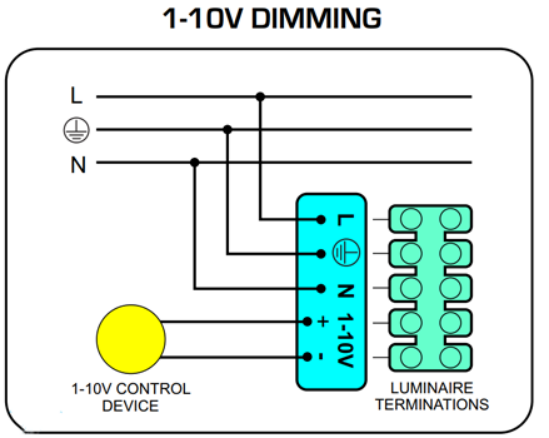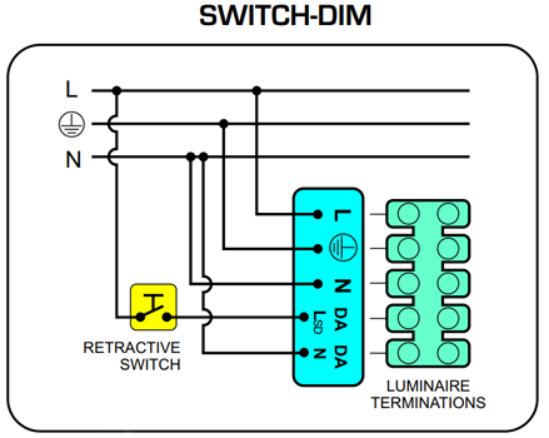
Privacy statement: Your privacy is very important to Us. Our company promises not to disclose your personal information to any external company with out your explicit permission.
![]() April 26, 2024
April 26, 2024
If the driver is separate from the lighting fixture, or is accessible within it, then the best way to dim the LEDs will be by using a dimming driver. This is how most dimming is achieved in commercial and industrial installations.
If desired, the driver can be the dimming type, performing the twin functions of a driver (transforming the incoming power from 230V AC to 12-24v DC) and a dimmer.
A dimming driver performs two functions: it is both a driver and a dimmer.
As a driver it converts the mains AC supply (typically 230V, 50Hz) to 12-24V DC. This is necessary because LEDs don’t operate on mains. LEDs work at low voltages on direct current.
As a dimmer it raises and lowers the amount of electrical energy flowing out to the LEDs. There are two mains ways that a driver does this - pulse width modulation (PWM) or amplitude modulation (AM) - and these are discussed below. However, if a driver uses PWM or AM is generally of little interest to an installer or specifier. They are internal to the driver and have little or no effect on the end user and the quality of the dimmed light they will see. The more important question for the specifier and installer is how the driver is to be instructed to make the LEDs brighter or dimmer.
There are several ways to control a driver, or instruct it what to do. In each case the driver will require a continuous supply of mains power plus a control signal to tell it what to do. The most common methods of controlling a driver are as follows:
DALI (Digital Addressable Lighting Interface). DALI is the most widespread communications protocol for commercial lighting control in use today. A DALI signal is delivered to the led driver(s) via two wires that are in addition to the wires delivering the mains supply. Many manufacturers supply LED Drivers that will accept a DALI input. For more information please read the article "What is the difference between DALI DT6 and DT8?"

This is how a DALI driver would normally be wired.
1-10V analogue control. This is an analogue communication protocols. Like DALI, it is delivered to the driver on two wires that are in addition to the mains wires.

This is how a 1-10V driver would normally be wired.
Switch dim, touch dim, push dim. These all use one extra wire carrying an additional mains supply to a dedicated terminal on the driver. The control device is usually a retractive (non-latching) switch making/breaking the wire carrying the additional live supply; a quick push on the retractive switch will cause the driver to switch the LEDs on/off while a longer push instructs the driver to dim the LEDs up or down.

This is how a driver would be wired for switch dim, touch dim or push dim control.
Corridor function. This is a variation on switch dim/touch dim/push dim (above). As with switch dim, an additional mains supply is connected to a dedicated terminal in the driver. However, instead of using a retractive switch as the control device, corridor function uses a latching switch, typically a motion sensor (PIR or microwave) or a time switch. This connects or disconnects the additional mains supply which indicates to the driver that is should switch the LEDs on, off or dim to a pre-set level.
DMX (Digital Multiplex). This is a communications protocol that originated in theatre lighting but which is also widely used for other colour changing applications such as façade lighting.
Wireless control. Several wireless technologies are available for communicating with LED drivers, including Zigbee and Bluetooth.
HOW A DIMMING DRIVER WORKS
A dimming driver has two functions:
Examples of dimming drivers as would commonly be used in or alongside commercial/industrial LED light fittings. Both these units perform dual functions; they are both a driver and a dimmer.
To function as a dimmer they both have extra terminals where control wires can be connected to provide a dimming control signal.
Drivers may use either of two techniques to reduce the amount of energy flowing to the LEDs.
Pulse width modulation (PWM)

An LED Driver that dims by using PWM is switching the power to the LEDs on and off. The longer the “on” pulses and the shorter the “off” pulses, the brighter the LEDs will appear to be, and vice versa. Provided this takes place at a frequency greater than about 200Hz any flickering will not be visible to the human eye and the brain will average the perceived level of brightness.
Amplitude modulation (AM). Here the driver is simply increasing or decreasing the output current to the LEDs. The risk of flicker is eliminated, but some LEDs change colour slightly if their current is altered, especially at low levels.
Some LED driver manufacturers use a combination of PWM and AM to achieve an optimal performance.
The above is the DIMMING LEDS WHICH HAVE A SEPARATE DRIVER we have listed for you. You can submit the following form to obtain more industry information we provide for you.
You can visit our website or contact us, and we will provide the latest consultation and solutions
Send Inquiry
Most Popular
lastest New
Send Inquiry

Privacy statement: Your privacy is very important to Us. Our company promises not to disclose your personal information to any external company with out your explicit permission.

Fill in more information so that we can get in touch with you faster
Privacy statement: Your privacy is very important to Us. Our company promises not to disclose your personal information to any external company with out your explicit permission.